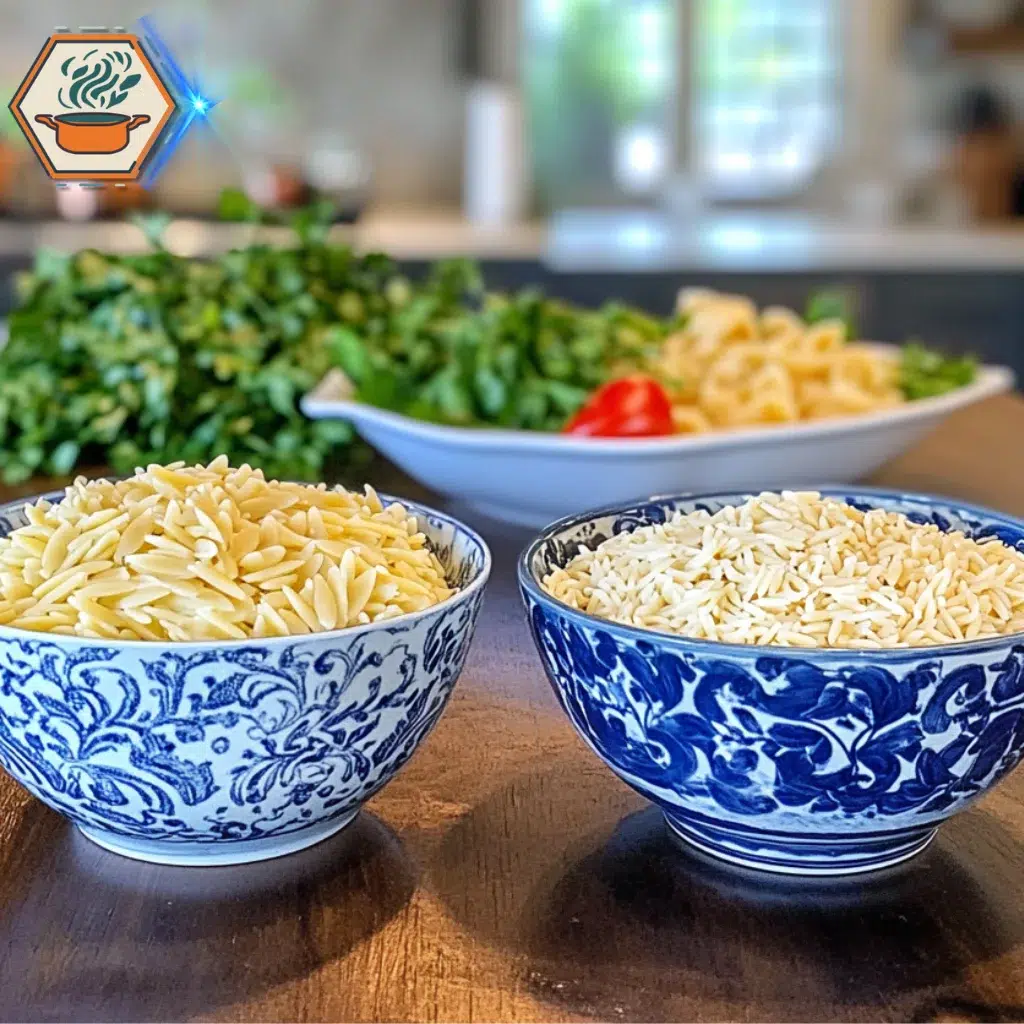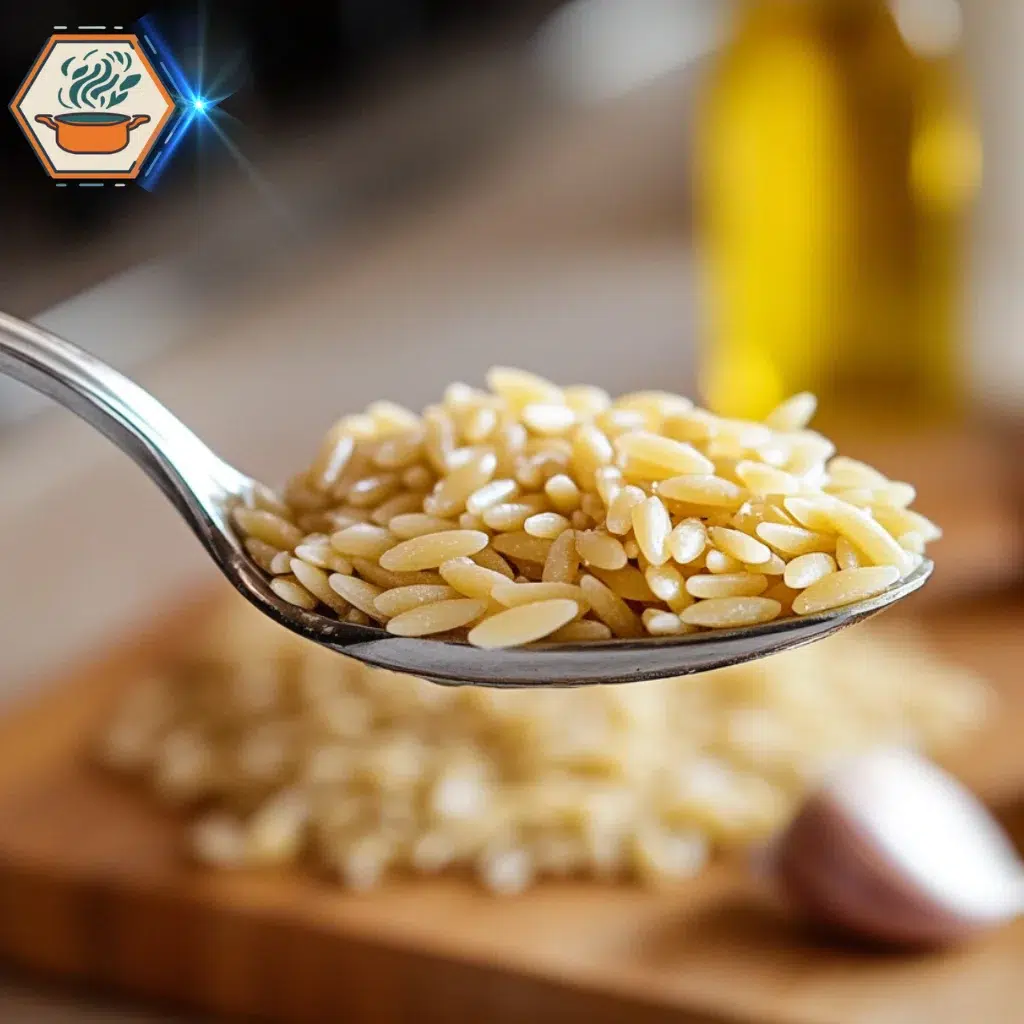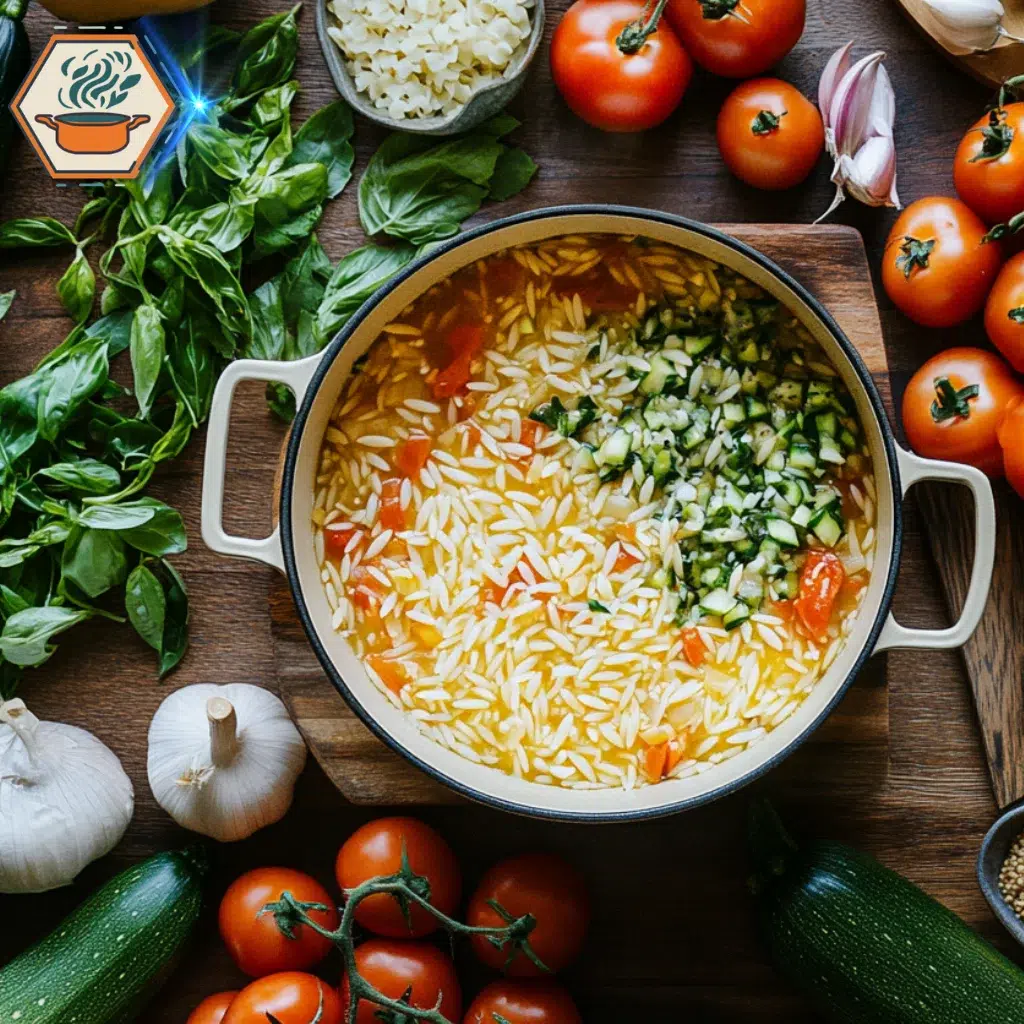Time to read:10 minutes
Table of Contents
Introduction
1.1 What You Need to Know About Orzo vs Acini di Pepe
Orzo vs Acini di Pepe is a common culinary comparison. Orzo, shaped like a large grain of rice, stands out in many recipes.. Originating from Italian cuisine, it is made from durum wheat, giving it a firm texture when cooked. Orzo is versatile and blends well with various flavors, making it a popular choice in many recipes.
1.2 What is Acini di Pepe?
Acini di Pepe translates to “seeds of pepper” in Italian. These tiny, bead-shaped pasta pieces are often used in soups and desserts like Italian wedding soup and frog eye salad. Made from semolina flour, they cook quickly and have a slightly chewy texture, ideal for dishes where a smaller pasta is needed.
1.3 Substitution Guide for Orzo vs Acini di Pepe
There are times when Acini di Pepe is unavailable, or you may prefer the texture of orzo. Substituting orzo can provide a similar starchy base while offering a slightly larger size and firmer bite. This works well in soups, salads, and even some casseroles. Choosing the right substitute ensures the dish maintains its flavor and structure.
For more substitution ideas, check our detailed guide on What is strawberry puree made of?
1.4 Importance of Choosing the Right Substitute in Recipes
Using the correct substitute is essential for preserving the dish’s original taste and texture. While orzo and Acini di Pepe are both pasta, their sizes and textures differ, which can affect the final outcome. Selecting an alternative like orzo helps maintain the recipe’s balance without compromising its authenticity.
For detailed information on pasta types, you can refer to Wikipedia’s Pasta List.
Comparing Orzo and Acini di Pepe
Orzo and Acini di Pepe are both small pasta types that often confuse many due to their size and usage. However, they have distinct differences in appearance, texture, cooking characteristics, nutritional profiles, and culinary applications.
2.1 Visual Differences Between Orzo and Acini di Pepe

- Orzo: Shaped like a grain of rice, orzo is slightly larger and has an oval, flattened form. Its name means “barley” in Italian, reflecting its resemblance to the grain.
- Acini di Pepe: Translating to “seeds of pepper” in Italian, acini di pepe consists of tiny, round pasta resembling peppercorns or small beads. They are significantly smaller than orzo, often compared to couscous in size.
2.2 Texture and Cooking: Orzo vs Acini di Pepe
- Orzo: When cooked, orzo has a firm yet tender bite, making it versatile for various dishes. It typically requires 8 to 10 minutes of boiling in salted water to reach an al dente texture.
- Acini di Pepe: This pasta offers a delicate, slightly chewy texture when cooked. Due to its small size, it cooks faster, usually within 4 to 9 minutes. It’s commonly used in soups like Italian wedding soup, where its petite size complements the broth and other ingredients.
2.3 Nutritional Profiles Comparison
Both orzo and acini di pepe are made from semolina flour, deriving from durum wheat, and share similar nutritional profiles.
- Calories and Macronutrients: A standard serving (about 2 ounces or 56 grams) of either pasta provides approximately:
- Calories: 200
- Carbohydrates: 42 grams
- Protein: 7 grams
- Fat: 1 gram
- Fiber Content: Whole wheat versions of these pastas offer higher fiber content, aiding in digestion and providing a sense of fullness.
- Vitamins and Minerals: Both types are good sources of B vitamins and iron, essential for energy metabolism and oxygen transport in the body.
2.4 Best Dishes to Try with Orzo vs Acini di Pepe
- Orzo:
- Salads: Orzo is popular in cold pasta salads, mixed with vegetables, herbs, and dressings.
- Soups: It adds substance to brothy soups, enhancing texture and making the dish more filling.
- Pilafs: Often used as a rice substitute, orzo can be sautéed and simmered with broth and spices to create flavorful side dishes.
- Acini di Pepe:
- Soups: A staple in Italian wedding soup, acini di pepe pairs well with broths, vegetables, and meats.
- Salads: Featured in dishes like Frog Eye Salad, a sweet pasta salad popular in certain regions.
- Desserts: In some cultures, it’s incorporated into sweet dishes, combined with fruits and creamy components.
Understanding the distinctions between orzo and acini di pepe allows for better culinary choices, ensuring the appropriate pasta is selected to complement and enhance the desired dish.
Substitution Guide for Orzo vs Acini di Pepe

When cooking Italian recipes or soups that call for acini di pepe, finding a substitute might seem challenging. However, alternatives like orzo can seamlessly replace acini di pepe with a few adjustments. Below, we’ll explore when to use orzo, what recipes work best, how to adjust cooking techniques, and tips to keep the dish’s original flavor.
3.1 When to Use Orzo as a Substitute for Acini di Pepe
In the Orzo vs Acini di Pepe debate, orzo proves to be an excellent substitute, providing a similar starchy base while adding a unique texture to soups and salads.. Here are some scenarios where substituting orzo is a great choice:
- Soups:
- In brothy soups like Italian Wedding Soup or chicken broth-based soups, orzo absorbs flavors without overwhelming the dish.
- Example: If acini di pepe is unavailable, add the same weight of orzo to maintain consistency.
- Casseroles:
- For baked dishes like creamy pasta casseroles, orzo adds bulk and texture.
- Salads:
- Cold pasta salads, such as those with vinaigrette or mayonnaise-based dressings, benefit from orzo’s slightly firmer bite.
Important: Avoid using orzo in desserts, such as Italian custards that require acini di pepe, since its size and starch content could alter the texture.
Cooking Tip:
When replacing acini di pepe with orzo, consider the dish’s liquid absorption. Orzo may absorb more liquid, so keep extra broth or sauce on hand to balance the recipe.
3.2 Perfect Recipes for Substituting Orzo vs Acini di Pepe
Some recipes are particularly forgiving when switching acini di pepe with orzo. Below are a few examples:
- Hearty Soups:
- Italian Wedding Soup
- Minestrone Soup
- Chicken Noodle Soup with a twist
- Pasta Salads:
- Mediterranean Orzo Salad: Toss with olives, feta, and a lemon vinaigrette for a refreshing dish.
- Italian Herb Pasta Salad: Mix with fresh basil, mozzarella, and cherry tomatoes.
- Comfort Food:
- Creamy Chicken and Orzo Bake: A casserole where orzo mimics the texture of acini di pepe but adds richness.
- Side Dishes:
- Herb Butter Orzo: A flavorful substitute for risotto.
3.3 Adjusting Cooking Times and Ratios
When using orzo in place of acini di pepe, cooking times and ratios need careful attention. Here are guidelines to follow:
- Cooking Times:
- Orzo typically cooks in 8-10 minutes, compared to acini di pepe’s 6-8 minutes.
- To avoid overcooking, check the pasta 1-2 minutes earlier than the package suggests.
- Liquid Ratios:
- For soups, start with slightly less broth. Add more as needed, since orzo can absorb more liquid over time.
- For salads, rinse the cooked orzo under cold water to stop it from continuing to soften.
- Portion Sizes:
- Use about 3/4 cup of orzo for every 1 cup of acini di pepe. This adjustment accounts for orzo’s larger size and higher density.
3.4 Maintaining Authenticity with Orzo vs Acini di Pepe

When comparing orzo vs acini di pepe, maintaining recipe authenticity while substituting one for the other requires careful attention to flavor, texture, and presentation. Despite their differences in size and shape, both types of pasta can work seamlessly in various dishes if you follow these expert tips:
Season Properly
To ensure your Crispy Pancake Recipe or any dish stays flavorful:
- Incorporate fresh herbs like basil, parsley, or oregano, which complement both orzo and acini di pepe.
- Enhance depth by including aromatics such as garlic, onion, or shallots. These bring out the savory notes of your recipe, regardless of the pasta choice.
Control Texture
Texture is a crucial factor when substituting orzo for acini di pepe:
- Cook orzo al dente to replicate the slightly firm bite of acini di pepe, ensuring the dish feels authentic.
- Be cautious not to overcook orzo, especially in salads, soups, or recipes where the pasta’s texture significantly impacts the final result.
Balance Ingredients
The balance of ingredients plays a pivotal role when swapping acini di pepe for orzo:
- In brothy soups or light salads, where smaller pasta like acini di pepe helps suspend ingredients, adjust by adding more finely chopped vegetables or smaller pieces of meat to achieve the same balance.
- For casseroles or baked dishes, consider reducing the liquid slightly, as orzo tends to absorb more liquid than acini di pepe.
Presentation Matters
Presentation can elevate the appeal of both orzo and acini di pepe dishes:
- Finish with visual garnishes like grated Parmesan, chopped fresh parsley, or a drizzle of extra virgin olive oil.
- Consider serving in shallow bowls to highlight the pasta’s shape and texture, whether you’re showcasing orzo or acini di pepe.
Flavor Pairing: Orzo vs Acini di Pepe
- While acini di pepe often works well in lighter dishes like Italian Wedding Soup or brothy vegetable soups, orzo’s slightly larger size makes it more versatile for heartier meals, such as Mediterranean salads or creamy baked casseroles.
- Experiment with bold flavors like lemon zest, sun-dried tomatoes, or capers when using orzo in recipes traditionally made with acini di pepe to enhance the unique texture without losing the dish’s essence.
Substitution in Soups, Salads, and Beyond
When transitioning between orzo and acini di pepe:
- In soups, focus on the liquid-to-pasta ratio. Orzo, being larger, may require a slight adjustment in broth quantity to maintain the correct consistency.
- In salads, toss orzo gently with olive oil after cooking to prevent clumping, mimicking the loose, individual grains of acini di pepe.
By carefully adapting your recipes with these tips, you can easily substitute orzo for acini di pepe (or vice versa) while maintaining the dish’s authenticity and delivering a delightful culinary experience. Whether crafting a Crispy Pancake Recipe side dish, a soup, or a hearty salad, both pasta options can shine with the right approach.
PrintOrzo vs Acini di Pepe: The Ultimate Substitution Guide
Learn how to perfectly substitute orzo for acini di pepe in soups, salads, and casseroles with expert tips. Discover their differences, nutritional profiles, and how to make your dishes shine using these versatile pasta options.
- Total Time: 20 minutes
- Yield: Serves 4
Ingredients
- cup orzo pasta (or substitute with acini di pepe if available)
- 4 cups chicken or vegetable broth (adjust as needed)
- 2 tbsp olive oil
- 1 clove garlic, minced
- 1 small onion, finely chopped
- 1 cup diced vegetables (carrots, celery, etc.)
- 1 tsp dried basil or parsley
- Salt and pepper to taste
- Optional: Grated Parmesan cheese for garnish
Instructions
- Prep: Heat the olive oil in a medium saucepan over medium heat. Add garlic and onion, sauté until fragrant.
- Cook Vegetables: Add diced vegetables and cook for 5 minutes until softened.
- Add Orzo: Stir in orzo pasta, coating it in the oil and aromatics for 1-2 minutes.
- Simmer: Pour in the broth and bring to a boil. Reduce heat and simmer for 8-10 minutes (or 6-8 minutes for acini di pepe) until the pasta is al dente. Stir occasionally to prevent sticking.
- Season: Add basil, salt, and pepper to taste. Adjust seasoning as needed.
- Serve: Ladle into bowls and garnish with Parmesan cheese, if desired.
Notes
- Substitution Tip: Orzo absorbs more liquid than acini di pepe, so keep additional broth on hand to adjust consistency.
- Dietary Option: Use whole wheat or gluten-free orzo for added fiber or dietary preferences.
- Customization: Add cooked chicken, meatballs, or tofu for a more filling meal.
- Storage: Refrigerate leftovers in an airtight container for up to 3 days.
- Prep Time: 10 minutes
- Cook Time: 10 minutes
- Category: Soups, Salads, Casseroles
- Method: Boiling, Simmering
- Cuisine: Italian
FAQs: All About Orzo vs Acini di Pepe
When it comes to cooking, substitutions can make or break a recipe. Here, we address common questions about Acini di Pepe and Orzo to help you cook with confidence.
Can Orzo Be Used as a Substitute for Acini di Pepe?
Yes, orzo can be used as a substitute for Acini di Pepe in many recipes. In the context of Orzo vs Acini di Pepe, orzo’s slightly larger size and firmer texture make it ideal for soups, salads, and casseroles. However, it’s important to adjust cooking times and liquid ratios since orzo absorbs more liquid compared to Acini di Pepe.
What Are the Main Differences Between Orzo and Acini di Pepe?
When comparing Orzo vs Acini di Pepe, the key differences lie in their size, texture, and culinary applications. Orzo is rice-shaped and larger, providing a chewy texture, while Acini di Pepe is small and bead-like, offering a delicate and creamy texture in soups and desserts. Each pasta shines in specific dishes, so choosing the right one depends on the recipe.
Which Pasta Is Better for Soups: Orzo or Acini di Pepe?
In the debate of Orzo vs Acini di Pepe, both are excellent for soups but serve different purposes. Acini di Pepe’s tiny size suspends beautifully in broth-based soups like Italian wedding soup. Orzo, on the other hand, adds a heartier bite and works well in thicker, more filling soups like minestrone.
Can You Use Orzo Instead of Acini di Pepe in Salads?
Yes, orzo can be used instead of Acini di Pepe in salads. When considering Orzo vs Acini di Pepe, orzo is a better choice for salads due to its larger size and firmer bite, which hold up well under dressings. Acini di Pepe is better suited for creamy or dessert-style salads, such as frog eye salad.
Is Orzo or Acini di Pepe More Nutritious?
The nutritional profiles of Orzo vs Acini di Pepe are quite similar, as both are made from semolina flour. A standard serving of either provides approximately 200 calories, 42 grams of carbohydrates, and 7 grams of protein. However, whole wheat versions of both pasta types offer higher fiber content, making them a healthier option.
What Are Some Recipes Featuring Orzo vs Acini di Pepe?
Popular recipes for Orzo vs Acini di Pepe include:
Orzo: Mediterranean orzo salad, creamy chicken orzo bake, and minestrone soup.
Acini di Pepe: Italian wedding soup, frog eye salad, and creamy custard desserts.
Both pasta types can be used in versatile ways, depending on the dish’s requirements.
How Do Cooking Times Differ for Orzo vs Acini di Pepe?
In the Orzo vs Acini di Pepe comparison, cooking times differ due to size. Orzo typically cooks in 8-10 minutes, while Acini di Pepe takes 6-8 minutes. It’s important to monitor cooking closely to achieve the desired al dente texture, especially when substituting one for the other.
Can Acini di Pepe Be Used in Place of Orzo in Casseroles?
While Acini di Pepe can technically replace orzo in casseroles, the Orzo vs Acini di Pepe comparison shows that orzo’s larger size and firmer texture make it better suited for baked dishes. Acini di Pepe may lose its structure in casseroles, resulting in a creamier but less visually appealing dish.
What Are Good Alternatives for Orzo vs Acini di Pepe?
If you don’t have either pasta on hand, consider these substitutes based on the Orzo vs Acini di Pepe comparison:
For Orzo: Arborio rice, pearl barley, or Israeli couscous.
For Acini di Pepe: Couscous, quinoa, or ditalini pasta.
Each alternative works best when chosen to match the dish’s texture and flavor profile.
Conclusion: Orzo vs Acini di Pepe – Finding the Perfect Fit
When it comes to the debate of orzo vs acini di pepe, both pastas hold their own unique charm in culinary applications. While acini di pepe shines in dishes like Italian wedding soup or desserts like frog eye salad, orzo steps in as a versatile substitute that works seamlessly in soups, salads, casseroles, and even risottos. Understanding the differences in size, texture, and cooking methods allows you to make thoughtful adjustments while preserving the authenticity of your recipe.
For example, if you’re preparing a traditional soup where acini di pepe’s tiny shape is key to the dish’s texture, choosing orzo and cooking it to an al dente firmness ensures the dish still achieves its desired consistency. Similarly, orzo’s slightly larger size can be balanced with additional vegetables or proteins to create a satisfying meal that respects the essence of the original recipe.
Ultimately, the choice between orzo and acini di pepe depends on the context of the recipe and your personal preferences, but both offer unique opportunities to elevate your culinary creations. So, embrace the flexibility these pastas provide and enjoy the delicious possibilities they bring to your table!

